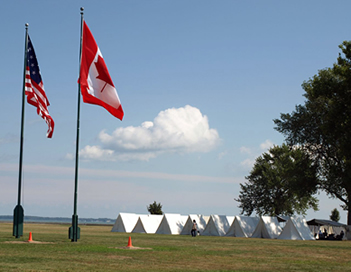
Courtesy of GoBucks2, Flickr's Creative Commons
|
Today the American and Canadian flags commemorate the struggle to define the boundary between the two countries
Courtesy of GoBucks2, Flickr's Creative Commons |
The Battle of Lake Erie was a turning point in the War of 1812. The War of 1812 removed the possibility of European expansion into territory claimed by the United States and greatly lessened the threat of large-scale resistance by American Indians to westward territorial expansion by the United States. In many ways, the War of 1812 began not with new problems facing a young America but with unresolved conflicts with the British stemming from the American Revolution. While the Revolution formally separated the American colonies from England, it did not completely remove British influences from American soil. After the revolution, England continued to station soldiers in the United States, maintain ties to some American Indian tribes, and claim a loosely defined boundary between British Canada and America. The combination of these tensions led to the War of 1812 and the Battle of Lake Erie in 1813.
 |
|
The large column that forms the memorial on a stormy summer's day
Courtesy of the National Park Service |
At Lake Erie, American forces under the leadership of Oliver Hazard Perry (1785-1819), defeated the British, won control of the lake, and, ultimately, the ability to maneuver troops to make a claim for land to the northwest. At this battle, Perry wrote his famous line: “We have met the enemy and they are ours.” Perry’s decisive victory was a blow to the British and a key to enabling American troops to secure territory in the northwest. Most importantly, though, his command of Lake Erie would help establish American claims to a northern border with Canada during the formation of the Rush-Bagot Pact. This pact began to resolve disputes between Canada and the United States over where the boundary between the two lay and that this boundary should be unfortified and lightly patrolled. The peace of Perry’s victory, then, not only helped end the War of 1812, but it also helped establish the peace that lasts till now in Canadian-American relations.
Named for Acting Secretary of State Richard Rush and the representative of the British government, Sir Charles Bagot, the Rush-Bagot Pact is part of this lasting peace. While the Treaty of Ghent ended the War of 1812, it did not completely resolve the issues that drove the nations to war in the first place. The United States still looked west for “unsettled” land without a clear sense of where its territory ended and British land began. A firm line between British North America and the United States would be important as the country grew. The Rush-Bagot Pact began the process of defining this boundary. To protect their remaining interests in North America, the British could have insisted upon a fortified border, however, neither the Americans nor the British wanted to maintain a large standing force in the Great Lakes. The Rush-Bagot Pact ensured that each side would have set, mutually agreed upon numbers and types of vessels in each of the Great Lakes. This greatly reduced the pressure to build up large fleets in the region and resulted in a corresponding sense that a great military presence was not necessary. While the agreement that Rush and Bagot assembled did not resolve all issues regarding the placement of the entire boundary between British North America and the United States, it did encourage each side to see the other as a potential trading partner or, at least, no longer an enemy.
Perry’s Victory and International Peace Memorial National Memorial is located on Put-in-Bay, South Bass Island, Ohio, Perry’s base of action both before and during the battle. Almost 50 feet taller than the Statue of Liberty, the memorial itself is the largest Doric column ever built and was designed after an international competition from which the winning design by Joseph H. Freelander and A.D. Seymour was chosen. Constructed between 1913 and 1915, the memorial includes an observation platform at its cap and a rotunda in its base that records the names of the American dead and wounded from the Battle of Lake Erie and the text of the Rush-Bagot Pact. From the observation platform, visitors can see where Perry led his troops at the Battle of Lake Erie.
Perry's Victory and International Peace Memorial National Memorial, a unit of the National Park System, is located within the Village of Put-in-Bay on South Bass Island, OH. Click here for the National Register file: text and photos. The memorial may be reached by private plane, commercial air carriers, passenger and car ferry, airboat, or private boat. On the island, taxi service is available. For more information, including information on traveling by boat and plane to the island and operating hours, visit the National Park Service Perry’s Victory and International Peace Memorial National Memorial website or call 419-285-2184.
Generally the memorial and visitor center are open regularly, but have seasonal hours. Note: The memorial column will be closed for restoration in 2011. The visitor center will remain open, and programs with rangers will continue, including special tours highlighting the construction and repair work. Ranger-led talks about the monument, the Battle of Lake Erie, and the War of 1812 are offered seasonally. Weapons demonstrations are conducted periodically. The memorial has also been documented by the National Park Service’s Historic American Buildings Survey.
Last updated: August 4, 2017
